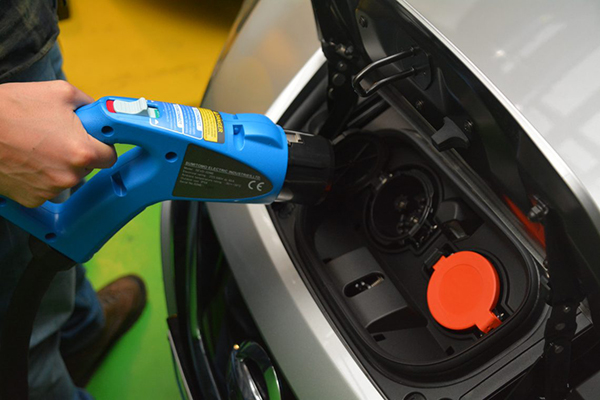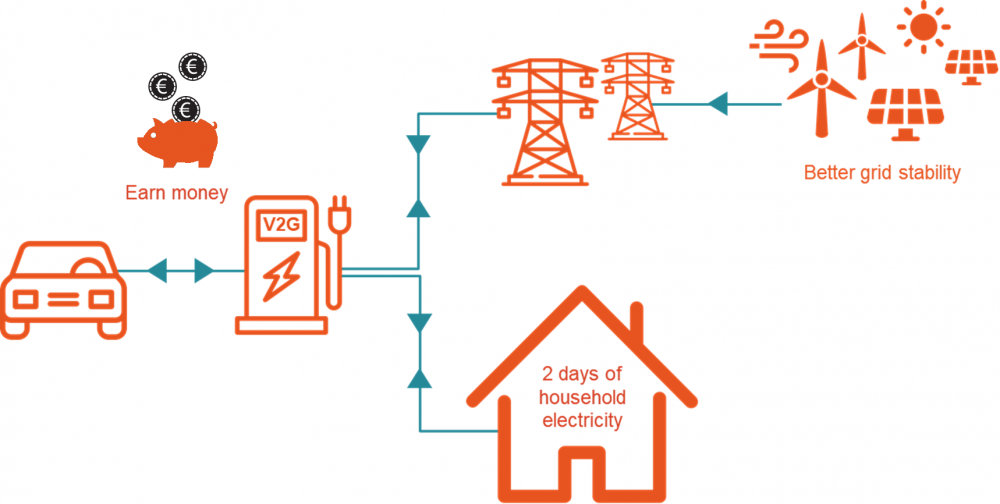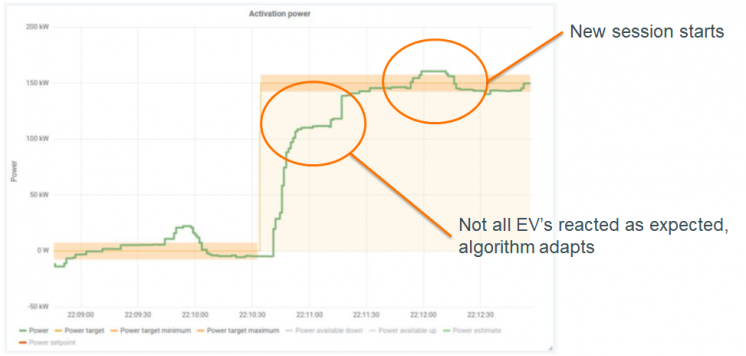18 January 2023
Using electric vehicles to balance the network
Recent predictions of electric vehicle (EV) uptake state that by 2030, 1.2 million EVs will be in use in Belgium. If managed incorrectly, these new types of consumption can put a significant pressure on the grid, for instance by increasing the evening peak load.
Why this project
On the other hand, we know that an average car is parked for more than 90% of the time. This means that the inherent flexibility of the charging process and the battery capacity offer great opportunities to support the grid. Elia Group decided to grasp the opportunities of EV’s and anticipate the possible problems.
For the grid operator, one possible use case for leveraging the potential of EVs is to use them for providing reserve capacity to the grid. Indeed, to balance the grid, transmission system operators (TSO) call upon balancing products, which are power sinks or sources used to counteract frequency disturbances in an attempt to restore the equilibrium quickly. Due to the nature of EVs, we estimated that the first balancing product to be tested should be FCR, or frequency containment reserve. This is the fastest kind of reserve that is procured by European TSOs. It is particularly suitable for battery technology because batteries can react immediately to a power request.
We wanted to test whether we can increase the charge power when the grid load suddenly drops or decrease the charge speed when the grid load is too high. In this case, big pools of EVs would be an ideal source of flexibility for the grid. Additionally, if we could make use of the energy stored in the battery of the vehicle, the balancing opportunity becomes even bigger. This last step can be achieved by using a special type of charging unit that enables both charging and discharging of vehicles: the so called vehicle-to-grid.
This way, we can turn EV uptake into an opportunity, while enabling end users to generate value when the car is parked.
[1] It is crucial that electricity production equals consumption at all times, thus that the electricity grid is always in perfect balance (more information here). In case of imbalance, for instance if the electricity generation exceeds the consumption, the grid frequency will deviate from its nominal value of 50 Hz.

Approach
-
The technologyAs you have understood, for this project, we assessed the possibility of using EVs to deliver grid services: both unidirectional and bidirectional. The general description of such services is vehicle-to-grid, or V2G.
Unidirectional charge poles are units that can only charge the battery of the car, thus no energy can be delivered back to the network. However, by varying the time or charging or the charge rate in case needs from the grid arise, they can assist in stabilizing the network. They are often referred to as unidirectional V2G, or V1G.
Bidirectional charge poles are charge units that can be used to charge and discharge an EV’s battery. This means that, next to their conventional use of charging the vehicle’s battery, they are able to draw charged energy from the battery and inject it back into the grid. This service is called bidirectional V2G, or simply V2G. In case the energy is delivered to a household, a load, or any other consumer, the general term vehicle-to-anything or V2X is generally used. -
The situation in Belgium
Before this project, no demonstration of V2G had taken place in Belgium so far. This means that an important, not yet assessed factor was the match between EVs and the Belgian balancing market. Driving profiles and charging behavior of Belgian drivers need to be known and matched with the requirements for Belgian balancing products, in order to understand whether the expectations in terms of comfort can be safeguarded. Furthermore, the Belgian regulatory framework had yet to be explored.

-
The approach
In the context of the project, two bidirectional chargers have been operational in both a professional (at Elia) and a private environment (at an Elia employee). They were interfaced with a big pool of conventional, smart chargers. To do so, a number of e-drivers, owning a compatible charger, have been approached to participate in the pilot, and their feedback about smart charging has been collected.
In the meantime, the aggregation and control software to control and optimize this fleet of EVs has been developed and made ready for large-scale roll-out. The necessary communication channels were set up, to make sure dispatched signals could reach specific EVs.
More than 100 tests, experiments, validations and simulations have been carried out, over the course of almost a year. The characteristics and technical possibilities of different sized or composed pools have been analyzed, and real-life tests performed, simulating the integration in the market. Each tests lead us to new insights and improvements, on a technical as well as on a contractual level. Using the new insights, a gap analysis and benchmark have been performed and recommendations made regarding the design of FCR services using EVs. These insights can be extended to distributed assets in general.
This way we aimed to pave the way towards the integration of distributed assets in the Belgian balancing services market.
-
The partnersIn order for the V2G project to be a success, three different partners have been selected to be part of the project consortium.
NewMotion is the supplier and charge point operator, which means they provide and manage the necessary hardware. NewMotion manages the largest charging infrastructure network in Europe and the third largest worldwide.
Enervalis develops the required information platform and aggregation software, which means they are responsible for the appropriate pooling and charge power decision. Steering signals from Enervalis are sent to the EVs through the backend of NewMotion.
EVConsult provides EV implementation strategy and project management, and has been active in the electromobility sector since 2007. -
The supportThe project was one of the 11 projects selected by the Flemish government as part of its Clean Power for Transport plan for 2018.[2] This plan supports various projects for the use of environmentally friendly vehicles. The grant was worth €150.000.
[2] https://www.tommelein.com/vlaanderen-investeert-1-miljoen-euro-in-projecten-voor-milieuvriendelijke-voertuigen
Results
In general, the project can be called a success. Throughout the project it was demonstrated that both unidirectional and bidirectional chargers are practically compliant with the FCR prequalification requirements.[3] Minor attention points still exist, but they do not seem to be blocking for a smooth fit into the Belgian FCR market.
The first attention point is the pool size. It is clear that the pool used for this project, being a combination of 40 unidirectional charge points with two bidirectional poles, is too small for some reasons. The first reason is the minimum bid size for FCR being 1 MW, which is impossible to reach with 42 cars. Secondly, when looking at the reaction of a small pool the individual behavior of a single car is quite effectual. If one car plugs in, it is immediately visible in a pool of 40 cars (Figure 1). This effect would be damped out in a bigger pool.

Figure 1: As the algorithm learns which cars react slowly, or not at all, it will filter out these cars and the initial reaction profile will improve. The effect of a starting or ending charging session will be filtered out with an increasing amount of EVs in the pool.
Using the data about technical aspects of a big pool, driver profiles and charging behavior, we have been able to establish that 200 to 1200 cars are needed to guarantee one unit of FCR. One unit means 1 MW for 4 consecutive hours. The bigger the fraction of V2G poles in the pool, the lower the amount of cars needed to deliver this 1 MW.
Further challenges exist in terms of the reaction of individual cars. It turned out that not every EV – charger combination reacts in the same way to a specific command, for reasons sometimes unknown. It can happen that an EV goes in an idle state and takes a long time to react, other times the requested charge power is not reached, and sometimes a car only reacts to the first request and ignores subsequent requests. It is expected that, through gaining experience, the unpredictable behavior can be anticipated. These learnings are to be integrated by the dispatching algorithm, in order to ensure a satisfactory reaction.
Lastly, it is interesting to note that no additional hardware will be necessary at the end-user side. The only requirement is that the charge point is connected to the internet. All the necessary data collection and decision making will be handled on a central point, and signals will be dispatched to connected charge poles as necessary. This means that from an end-user point of view, no big hurdles block the rollout of V1G or V2G.
The recommendations
From the results, it is clear that from a technical point of view FCR can be delivered using EVs. Of course, financial and regulatory barriers still exist. For this reason, we formulated a list of recommendations towards policy makers.
These include prioritization of smart meter installation, prevention of vendor lock-in, capacity tariffs, and a smoothening of the procedures for grid operators for the balancing service provider. Lastly, it is important to offer a value proposition to the end customer, which means a financial impact analysis will be very important as a next step.
[3] The prequalification process is described in the FCR Terms & conditions
Partners
 |
 |
 |



